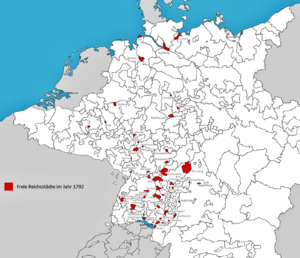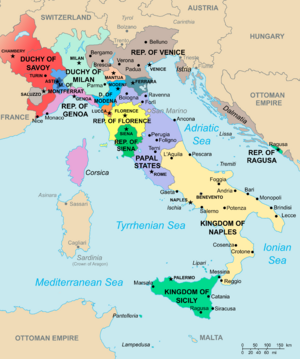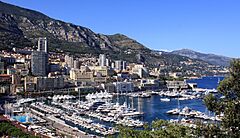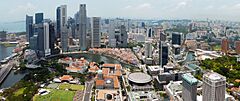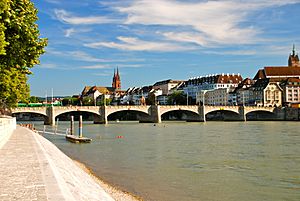City-state facts for kids
Imagine a city that is also its own country! That's what a city-state is. It's an independent city that acts like a small country. It has its own government, economy, and culture. Unlike a regular country with many cities and towns, a city-state is mostly just one big city.
Throughout history, many famous places were city-states. Think of ancient Athens and Sparta in Greece, or Rome and Carthage. During the Middle Ages and Renaissance, Italian cities like Florence and Venice were also powerful city-states.
Today, there are only a few true city-states left. The most famous ones are Singapore, Monaco, and Vatican City. Singapore is the biggest and has its own money, army, and a lot of influence around the world. It's often called the "world's only fully functioning city-state."
Some other cities are not fully independent countries but act a lot like city-states because they have a lot of self-rule. Examples include Hong Kong and Macau.
A Look Back: City-States Through History
Ancient Times
For thousands of years, cities have sometimes acted as their own small countries. These were the first city-states. In ancient Sumer (a very old civilization), cities like Uruk and Ur were independent. Ancient Egypt also had powerful city-states like Thebes and Memphis.
The Phoenician cities, like Tyre and Sidon, were important trading city-states. Perhaps the most famous ancient city-states were the Greek city-states, called poleis. Think of Athens and Sparta. They were rivals but also amazing centers of culture and power.
The Roman Republic started as a city-state. It grew from just the city of Rome into a huge empire! In other parts of the world, the Mayan cities in Mesoamerica, like Chichen Itza and Tikal, also functioned as city-states.
Medieval and Renaissance Eras
During the Middle Ages and the Renaissance in Italy, many cities became very rich and powerful. They were called Italian city-states. Cities like Florence, Venice, and Genoa were centers of trade, art, and new ideas. They often had their own armies and ruled over nearby lands.
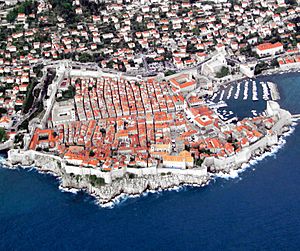
Other examples include the Republic of Ragusa in Croatia, which was a strong trading city. In medieval Russia, cities like Novgorod and Pskov also acted as independent city-states for a time. These small, independent cities often faced challenges from larger kingdoms and empires, which eventually led to many of them becoming part of bigger countries.
City-States in Central Europe
In the Holy Roman Empire, which existed for a very long time (from 962 to 1806), many cities were called Free Imperial Cities. These cities had a lot of freedom to govern themselves. They could make their own laws and even form alliances with other cities.
Some of these cities, like Bremen and Hamburg, were part of a powerful trading group called the Hanseatic League. This league helped them become very important in trade and politics. Even some parts of what is now Switzerland, like Zürich and Bern, started out as city-states.
After the Holy Roman Empire ended, some cities like Bremen and Hamburg officially became independent city-states for a while. This shows how important cities could be in shaping history.
Italian City-States
Northern and Central Italy were famous for their many city-states during the Middle Ages and Renaissance. These cities, like the Republic of Florence and the Duchy of Milan, were very important for trade and culture.
They were often ruled by powerful families or leaders. Some, like the Republic of Venice and Republic of Genoa, were called maritime republics because they were great at sea trade and had strong navies. These city-states played a huge role in shaping Europe's economy and art.
City-States in Southeast Asia
Southeast Asia also had its own forms of city-states. In places like Mainland Southeast Asia, cities called mueang were often self-governing. They sometimes paid tribute to larger, more powerful cities, creating a network of influence.
Important cities like Ayutthaya and Bangkok were at the center of these networks. In the Philippines, early communities called barangay also acted like small city-states, ruled by local leaders.
20th-Century Cities Under Special Supervision
In the 20th century, after big wars, some cities were given special international status. They were not fully independent countries but had a lot of self-rule.
Danzig
The Free City of Danzig was a special city-state between 1920 and 1939. It was a port city on the Baltic Sea (now Gdańsk, Poland). It was created after World War I to ensure fair access to the sea for different countries.
Fiume
The Free State of Fiume was an independent state from 1920 to 1924. This city (now Rijeka in Croatia) had a unique history of self-rule before becoming fully independent for a short time.
Jerusalem
After 1947, there was a plan for Jerusalem to become a special city-state. It would be controlled by the United Nations to ensure peace. However, this plan did not happen due to conflict, and Jerusalem was divided.
Shanghai
The Shanghai International Settlement (1845–1943) was a special international zone in Shanghai, China. It had its own laws and services, making it unique within the city.
Tangier
The city of Tangier in North Africa was an international zone from 1923 to 1956. Several countries managed it together. It later became part of Morocco.
Trieste
The Free Territory of Trieste was an independent area in Central Europe from 1947 to 1954. It was under the direct care of the United Nations Security Council after World War II.
West Berlin
From 1948 to 1990, West Berlin was a unique city. It was not officially part of any country but was ruled by the Western Allies. It had its own government and acted like a city-state, even though it wasn't fully sovereign.
Contemporary Sovereign City-States
Vatican City
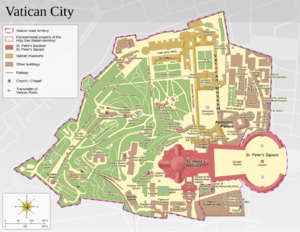
Rome was once controlled by the pope as part of the Papal States. In 1870, Rome became part of Italy. The pope then refused to recognize the new Kingdom of Italy.
This disagreement was solved in 1929 by the Lateran Treaties. These treaties recognized Vatican City as an independent state. The Pope is its head.
Vatican City has its own citizens, flag, and stamps. With fewer than 1,000 people, it is the smallest sovereign country in the world.
Monaco
The Principality of Monaco is a very small independent city-state next to France. Its famous areas like Monaco-Ville and Monte Carlo are all part of one continuous city. The Principality of Monaco and the city of Monaco govern the same area.
Monaco has a small military, mainly for ceremonies. It relies on France for defense if there's a serious threat.
Singapore
Singapore is an island city-state in Southeast Asia. It borders Malaysia to the north and Indonesia to the south. About 6 million people live and work in Singapore. This makes it one of the most densely populated countries.
Singapore became an independent country in 1965. It has its own money, a large international airport, and one of the busiest ports in the world. It also has its own strong armed forces to protect its independence. The Economist calls Singapore the "world's only fully functioning city-state."
Contemporary Non-Sovereign City-States
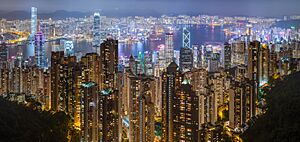
Some cities are not independent countries but have a lot of self-rule within a larger country. They act like "city-states" because they manage many of their own affairs.
Here are some examples of cities with a high degree of self-rule:
- China: Hong Kong and Macau (as special administrative regions)
- Spain: Ceuta and Melilla (as autonomous cities)
- United Kingdom: Gibraltar (as a British Overseas Territory)
- City of London (as a self-governing city within London)
Some cities are also states within a larger country (a federation). They are like non-sovereign city-states:
- Argentina: Buenos Aires
- Austria: Vienna
- Germany: Bremen, Berlin, and Hamburg
- Mexico: Mexico City
- Russia: Moscow and Saint Petersburg
- Switzerland: Basel-Stadt and Geneva
States with Similar Characteristics
Some other small countries are very much centered around one main city. They are sometimes called city-states, even if they have some smaller towns or rural areas. Examples include Luxembourg, Djibouti, Qatar, Brunei, Kuwait, Bahrain, and Malta. In these countries, the capital city is usually the most important place for everything.
Proposed City-States
Sometimes, people propose that certain cities should become independent city-states.
London
There is a movement that wants London to become a city-state separate from the United Kingdom.
Hong Kong
Some people in Hong Kong support the idea of Hong Kong becoming an independent country.
Sovereign State of the Bektashi Order
The Sovereign State of the Bektashi Order is a proposed city-state in Tirana, the capital of Albania. This state would be led by the Bektashi Order, a religious group. It is planned to be similar to Vatican City in its structure. If approved, it would be the smallest nation in the world.
See also
 In Spanish: Ciudad-Estado para niños
In Spanish: Ciudad-Estado para niños
- Charter city
- City network
- Consolidated city-county
- Federal district
- Pyu city-states
- Royal free city
- Sheikhdom of al-ʽIrqa
- List of fictional city-states in literature


